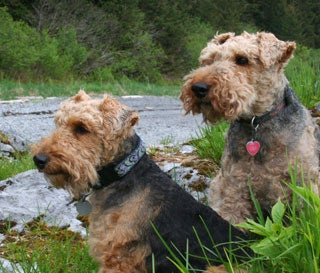Learn about dog breeds
Detailed information & photos on over 190 different breeds
Description
The Welsh Terrier is a strikingly attractive dog with its very sweet looking face, its tiny tail and its black and tan coloration. This is a medium sized dog that does not shed. The ears of this breed of dog sit almost on top of its forehead and flop towards its face. It has a brick-shaped face with fur fringes that makes the dog look like it is bearded and whiskered. Its eyes are very sad looking, and set far apart. The muzzle is short and blunt, and it is usually punctuated by a very dark colored cubed nose. The Welsh terrier has black lips and very strong canines.
Coat Description
The overcoat on this breed of dog is harsh under the touch - tough, wiry and quite dense. The softer undercoat helps provide insulation against possible drops in the temperature.
The Welsh Terrier is primarily black and tan. However, any dog that has red and brown coat coloration is also accepted in standard showmanship competitions. On very rare occasions, a dog would show up with white coloration on its coat, or its legs or even on its face – and this is still considered desirable according to breed standards. The chest, forelegs and head should be clear of any black coloration
The Welsh terrier always has a black or dark colored jacket or saddle – this (may) start from its collar, a great percentage of its back, its tail and on the upper portion of its hind quarters.
History
The line of the Welsh Terrier can be traced back as far as the 1700s to that of the Old English terrier. The Old English breed has been extensively used as foundation for the modern breeds of terriers, especially that of the English Broken-Haired terrier and the Welsh Terrier. However, dog enthusiasts decided that these two breed of dogs should become separately recognized and the Welsh Terrier officially made it on the registry of major kennel books in 1886. It is fortunate that the dog’s popularity has helped it thrive in various countries as pets, show dogs and working animals.
Temperament
The Welsh Terrier has an affectionate nature, extreme bundles of energy, and the fleet-footedness of any hunting dog. It is also very intelligent, wary of strangers and loyal to its human handlers. The Welsh Terrier is never shy and will always be the first to investigate stuff, people and places that it finds unfamiliar.
The Welsh Terrier needs to be kept active. Its intelligence and boundless energy needs to be put to use. Otherwise, it will become destructive in the long run – digging constantly, uprooting flowers and shrubs. Regular exercise and frequent breaks from its routine will help the dog keep fit and mentally stimulated. If the dog has enough activity to expend its energy, it can be very calm and docile during its off-time.
Health Problems
A Welsh Terrier is known to be susceptible to eye problems, especially syndromes associated to luxated lens: the unexplained dislocation of eye lenses from its pupils. When untreated, this can lead to secondary glaucoma and eventually to blindness. This breed also suffers from complications of thyroid deficiency, epilepsy, and minor skin problems.
Grooming
The great thing about a Welsh Terrier is that it does not shed. A stiff brushing weekly should suffice to remove coat matting and infrequent baths should be given at least once a month or once every two months. Twice a year, the Welsh Terrier needs to visit the local vet for coat plucking; otherwise it would be in danger of overheating due to its dense coats. An occasional fur trimming would be great to preserve its handsome stature. Nails are a particular concern, because this provides the traction the dog needs when it runs.
Exercise
Terriers should always be allowed the run about. This is necessary so that the dogs remain intellectually stimulated. The Welsh Terrier is of no exception. Regular agility training and running courses are two of its favored activities.
A Welsh Terrier is not prone to attack any stranger unprovoked, so if it comes across anyone unfamiliar, it will most likely sound the alert and show a measure of aggression, but nothing more. This means that the dog is safe to let loose in, say, a wooded area or a trail park. However, it is also prone to chase after anything that moves from ground hogs, to people on bicycles and even cars.
Training
The Welsh Terrier needs to be trained in socialization early in its life. Otherwise, the dog may become too timid around people, and may turn aggressive to young children’s rough handlings. Because of its liking for speed and any form of break from routine, this breed of dog can be exceptionally great in agility training and racing. Nonetheless, one of the most basic foundations for any dog training is obedience.
Since the dog is intelligent and shows all likelihood of pleasing its human handlers, the Welsh Terrier is relatively easy to train. However, it does have that naughty streak and may succumb more to play than actual training. Consistent training, variety in activities and positive reinforcements will help this breed of dog to master any form of training at a fast pace.
Advertise | Privacy Policy | Terms of Use | Contact Us © Copyright 2004-2024 PupCity.com. All rights reserved.
